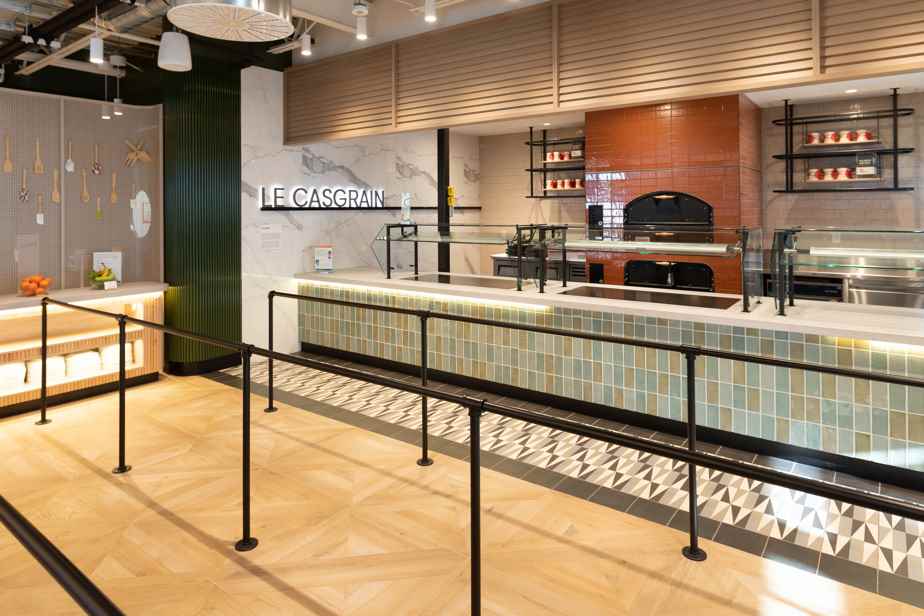At 9e floor, decorated on the theme of the Old Port, the receptionist’s office looks like a container, and a big GOOGLE MONTRÉAL takes up the famous Farine Five Roses illuminated sign.
Posted at 1:41 p.m.
Updated at 2:17 p.m.
The 10e floor takes up the aesthetics of Chinatown with a magnificent mural by Bryan Beyung, a Montreal artist from a family of Chinese-Cambodian refugees, while the cafeteria at 13e pays homage to the Jean-Talon Market and Little Italy.
For its Montreal offices, the official inauguration of which took place on Wednesday, Google wanted to “reflect the essence” of the metropolis, explained Jean-Philippe Gauthier, spokesperson. The half-hour visit offered to the journalists showed that the mandate was well understood, with attention to detail and the comfort of the employees rather impressive.
It should be noted that the press conference was held entirely in French, despite the presence of speakers whose mother tongue was obviously not that.
Mohawk Tree Names
At 9e floor, a space has been provided for the food and rest of dogs, which are allowed in the workplace. On the floor, a gray carpet has been woven with a Google map of the surroundings, and the new offices are shown in white. On the ceiling, if you pay attention to it, the panel filtering the light represents the Jacques-Cartier bridge.
Meeting rooms are named after trees in Mohawk, chosen by employees after consultation with the Kahnawake community. It was this consultation, it is said, that made it possible to discover that it was undesirable to choose the names of plants, some of which are considered sacred. A QR code allows you to know the pronunciation in French, English and Mohawk.

PHOTO FLORIAN LEROY, SPECIAL COLLABORATION
The conference rooms are named after trees in Mohawk.
At 10e floor, rest rooms, where you can meditate or take a nap, are offered.
Located at the junction of Chinatown and Old Montreal, the historic building has been completely renovated, while retaining its envelope and structure. The approximately 300 Google employees currently occupy three floors out of 13, and two other floors will be added soon. In addition to the three neighborhoods visited, we want to pay tribute to the Village and the Plateau.
Ultimately, Google announced in February 2020, these premises will be able to accommodate a thousand employees. We are far, very far from the first steps of Google in Montreal in 2004, when we hired three engineers working in shared workspaces.

PHOTO FLORIAN LEROY, SPECIAL COLLABORATION
For its Montreal offices, the official inauguration of which took place on Wednesday, Google wanted to “reflect the essence” of the metropolis, explained Jean-Philippe Gauthier, spokesperson (second from left).
An AI programmer
It is in these new walls in particular that “Googlers”, the name given to the staff, take care of the cybersecurity of the Chrome browser, cloud computing services and research in artificial intelligence.
Chrome’s security, it was recalled at a press conference, concerns some 4 billion devices and generates 250 million security alerts each month. “Some of Chrome’s most innovative features were developed here [à Montréal] », indicates Mr. Gauthier.

PHOTO FLORIAN LEROY, SPECIAL COLLABORATION
Hugo Larochelle, head of the artificial intelligence research team, Google Brain.
Research in artificial intelligence (AI), which brings together around thirty people under the direction of a world authority in this field, Hugo Larochelle, has been credited with around a hundred publications since the founding, in 2016, of the laboratory called Google Research. BrainTeam.
It is here, says Mr. Larochelle in an interview, that we developed the expertise for a rather inspiring project: the control and stabilization of balloons launched into the stratosphere to transmit the Internet network. The “Loon” project, however, was abandoned by Google’s parent company, Alphabet, in January 2021.
Less spectacular, but much more promising, another field of study for the Montreal laboratory consists of using machine learning to simplify the life of programmers, in particular by correcting errors. “It’s an increasingly popular field of application,” explains Mr. Larochelle. It’s a great example of using machine learning to free programmers from the more tedious tasks and allow them to be more creative. »

